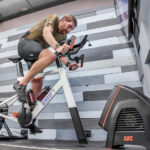Finding the perfect entry point into mountain biking can be exciting, but also a bit overwhelming. With so many options available, selecting the right “Good Starter Mountain Bike” is crucial for a positive and enjoyable introduction to the sport. This guide will break down what to look for in a beginner-friendly mountain bike, ensuring you make an informed decision and hit the trails with confidence.
What Makes a Good Starter Mountain Bike?
A good starter mountain bike isn’t about top-of-the-line components or breaking the bank. It’s about finding a reliable, durable, and confidence-inspiring bike that allows you to learn the fundamentals of mountain biking without frustration. Key characteristics of a good starter mountain bike include a robust frame, dependable components, and geometry that promotes control and stability. It should be versatile enough to handle various beginner trails while being upgradeable as your skills progress.
Key Components to Consider
When exploring your options for a good starter mountain bike, several components deserve your attention:
Frame Material
Most starter mountain bikes feature frames made from aluminum or steel. Aluminum frames are generally lighter, making them easier to handle and more efficient for climbing. Steel frames, while heavier, offer excellent durability and a comfortable ride quality, often at a more affordable price point. For beginners, both materials are viable options, with aluminum being slightly favored for its weight advantage.
Suspension: Hardtail vs. Full-Suspension
One of the biggest decisions is choosing between a hardtail (front suspension only) and a full-suspension mountain bike. For beginners, hardtail mountain bikes are often recommended as good starter mountain bikes for several reasons:
- Simplicity and Maintenance: Hardtails are less complex, with fewer moving parts, making them easier and cheaper to maintain.
- Efficiency: They are more efficient on climbs and smoother trails as all your pedaling power goes directly into forward motion.
- Affordability: Hardtails are typically more affordable than comparable full-suspension bikes, allowing you to get better components for your budget.
While full-suspension bikes offer increased comfort and control on rough terrain, they can be more expensive and require more maintenance. For your first mountain bike, a quality hardtail is often the smarter choice as a good starter mountain bike.
Components and Drivetrain
Focus on reliable and functional components rather than high-end, expensive ones for a starter bike. Shimano and SRAM are the two dominant brands in mountain bike components. Look for groupsets like Shimano Deore or SRAM SX Eagle, which offer a good balance of performance and durability at an entry-level price point. A wide range drivetrain (1x or 2x) is beneficial for tackling varied terrain.
Brakes
Disc brakes are a must-have for any mountain bike, including starter models. They provide significantly more stopping power and better modulation than rim brakes, especially in wet or muddy conditions. Mechanical disc brakes are common on entry-level bikes and offer reliable performance. Hydraulic disc brakes offer even better performance but come at a higher price point.
Wheel Size
Modern mountain bikes typically come with 27.5-inch or 29-inch wheels. 27.5″ wheels are more nimble and easier to maneuver, which can be beneficial for beginners. 29″ wheels offer better roll-over ability and momentum, making them more efficient on smoother trails and for climbing. Both are suitable for beginners; consider your height and riding style when choosing.
Recommended Starter Mountain Bikes
While specific models change year to year, focusing on brands known for quality entry-level bikes is a good strategy. Based on expert recommendations and value, here are a couple of examples, reminiscent of good options in the market:
K2 Attack 1.0 (Example of a Dual-Suspension Option)
The K2 Attack 1.0, as mentioned previously, represents a dual-suspension option at a more accessible price point. Featuring a Suntour front fork and a proprietary rear shock, it aims to provide a comfortable ride on varied terrain. The SRAM and Shimano drivetrain components ensure reliable shifting, while the aluminum frame keeps the bike relatively lightweight. While dual-suspension at this price point might have compromises, it introduces riders to the benefits of rear suspension early on. This could be a good starter mountain bike for those specifically wanting to experience full suspension from the beginning.
Novara Bonanza (Example of a Hardtail Option)
The Novara Bonanza, a house brand from REI, exemplifies a well-spec’d hardtail mountain bike for beginners. By opting for a hardtail design, the Bonanza prioritizes component quality and affordability. It boasts a Manitou fork, a mix of reliable Shimano drivetrain parts, and importantly, Hayes disc brakes – a feature often found on higher-priced bikes. This combination of components makes the Novara Bonanza a durable and enjoyable good starter mountain bike, perfect for learning the ropes of mountain biking.
Note: These are examples based on the original article. Current models and brands may vary. Always check for the latest reviews and available bikes in your local market.
Skills and Safety
Before hitting the trails, especially for beginners, investing in a bike skills class is highly recommended. Mountain biking techniques differ significantly from road biking, and proper instruction can drastically reduce the risk of accidents and enhance your enjoyment. Learning fundamental skills like body positioning, braking techniques, and obstacle negotiation will build confidence and make your mountain biking experience safer and more fun.
Conclusion
Choosing a “good starter mountain bike” is about balancing budget, component quality, and bike type to match your needs as a beginner. Focus on a reliable hardtail to learn the fundamentals, or explore entry-level dual-suspension options if comfort on rougher trails is a priority. Prioritize disc brakes and dependable components. Most importantly, get out there, ride, and enjoy the journey of mountain biking! Remember to consider taking a skills class to maximize your safety and fun on the trails.

